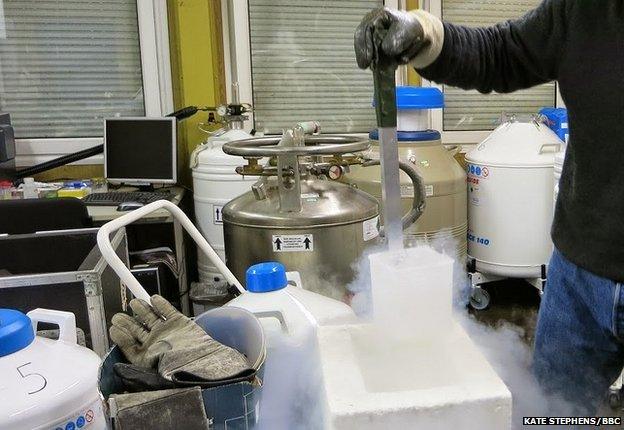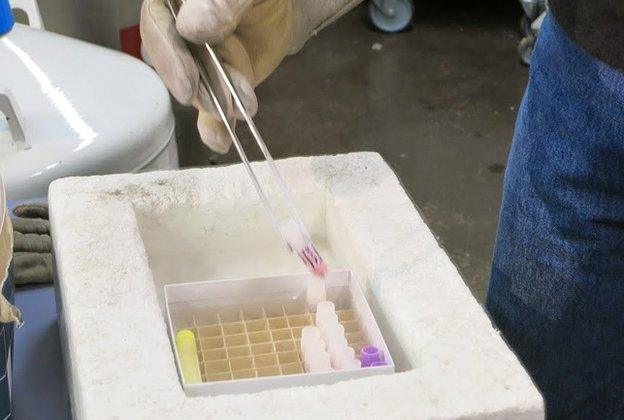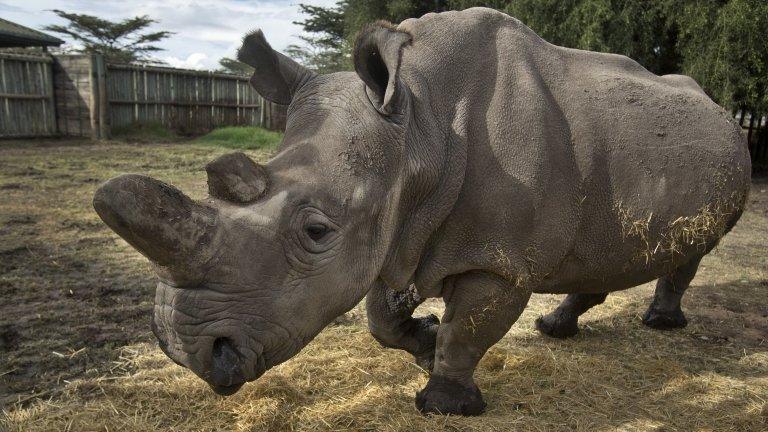Should we try to halt extinction?
- Published
- comments
IVF might be a solution to save the Northern White from extinction
In an age when mankind can send robots to look for life on Mars, why can't science stop so many forms of life from being wiped out here on Earth?
The question comes amid the loss of species on such a relentless scale that conservationists call it the Sixth Mass Extinction - the fifth being the asteroid that killed the large dinosaurs. This one is driven by human activity.
One immediate focus is on the pitiful story of one of Africa's greatest animals - in fact, its second largest mammal - the northern white rhino.
Decades of poaching have whittled down the numbers of this massive and fearsome-looking creature to a paltry band of survivors - and, because none of the usual conservation techniques have worked, the animals now total just five.
Weighing more than a tonne, and clad in a thick almost reptilian hide, the last of these rhinos are now all in some form of captivity.
Just for the record, they are grey rather than white - the word "white" is believed a mangling of their original description of their heads and mouths as "wide".
I was given the chance to touch one of them, a female called Nabire, at a zoo in the Czech Republic. Keeping a wary eye on her horns, I reached through the bars to the craggy skin above her right eye and was surprised at its feel of dried velvet, soft and dusty. Nabire stood patiently, looking more relaxed than me.
By a quirk of history, all five surviving northern white rhinos are owned by this particular zoo, known as Dvur Kralove, in the north of the Czech Republic - it prides itself on a remarkable collection of African animals originally built up in Communist times.

An institute in Berlin hopes that IVF could help revive animals such as the northern white rhino

Samples of sperm and eggs stored in liquid nitrogen could be used when the technology improves in future
Over the decades, the zoo's northern whites did produce a few calves but, when the births stopped, a radical decision was taken in 2009: to send four of the rhinos to Kenya in the hope that returning to their natural habitat would stimulate more breeding.
Sadly, the experiment in the Ol Pejeta wildlife sanctuary has not produced offspring and one of the two males has since died.
Earlier, another had been sent to San Diego Zoo, which has a proven track record of encouraging births among a related species, the southern white. But this did not work either.
So, as things stand, this species has had no live births for as long as 15 years.
This is a catastrophic situation when the population is already so tiny - the best examples of conservation have almost all started with double-digit numbers.
The giant pandas, for example, numbered several hundred when projects for assisted reproduction began. Larger numbers do not merely increase the odds of offspring, they also guarantee a healthier diversity of genes.
By contrast, when I saw Lonesome George, the last of his kind of giant Galapagos Tortoise, in 2008, it was already far too late to keep his species going.
The lack of births among the northern whites creates a physiological problem as well: the longer the female rhinos spend without being pregnant, the greater the chance of cysts developing in their uteruses.

Conservation efforts came too late for Lonesome George, the last of his kind of Galapagos tortoise
At this stage, every option for survival involves discussing the most intimate details of the animals, and some may find this distasteful.
The last male, Sudan, is too old to mount and his sperm is poor quality. One female in Kenya, Najin, has hind legs too weak to carry the weight of being mount. Her daughter, Fatu, has problems with her uterus. So does Nabire, in the Czech Republic. Nola, a female in San Diego, has passed reproductive age.
Over the years, artificial insemination (AI) has been tried, and although it has succeeded with plenty of other species, including other kinds of rhinos, it has never worked for the northern whites.

The last northern white rhinos
Angalifu - Male, 44 years old. Died at San Diego Zoo on 14 December
Nola - Female, approx. 40 years old. Lives at the San Diego Zoo. Attempts to mate her with Angalifu failed
Nabire - Female, 31 years old. Born in captivity. Housed at Dvur Kralove Zoo, Czech Republic
Sudan - Male, 43 years old. Lives in semi-wild state at Ol Pejeta Conservancy, Kenya. Captured from the wild at age three. Probably too elderly to mate naturally
Najin - Female, 25 years old. Lives at Ol Pejeta Conservancy. May still be a candidate for artificial insemination, but previous attempts in Czech Republic failed
Fatu - Female, 14 years old. Najin's daughter. Absence of pregnancies has probably rendered her infertile

The next step might be IVF - fertilisation in a test tube. Scientists from a leading laboratory, the Leibniz Institute for Zoo and Animal Research in Berlin, have used the technique to create an embryo for a black rhino, and they believe that it could help the northern whites.
Beyond that, they and others hope to use stem cells as another way of creating embryos.
And the thinking stretches into the future: if samples of sperm and eggs are collected and stored in deep cold liquid nitrogen, they would keep alive the hope of bringing back the northern whites when the technology makes it easier in the future.

Nabire has reproductive problems, but her eggs could be used for IVF
Already there are samples of sperm from the animals, together with samples of skin cells, but so far no eggs.
However these are controversial technologies in a field that has generally preferred to encourage conservation by the most natural means possible. Test tubes, freezers and genetic science do not sit comfortably with the more traditional approaches.
And there are questions of practicality and safety too: in one operation at Dvur Kralove zoo, a rhino died; in another, a keeper was killed. Over the years, the zoo has carried out as many as 30 sedations on seven different northern white rhinos, and each intervention brings risks.
All these issues will be in the minds of the zoo's senior staff as they meet conservation experts in Kenya in the coming days.
Since it was mankind that caused the demise of the species, should mankind feel obliged to use every technique to keep it alive?
Or is it better to recognise, however reluctantly, that the moment has passed, and that effort would be better focused on the next species facing extinction? This will not be the last time the question is raised.
- Published16 December 2014

- Published15 December 2014
